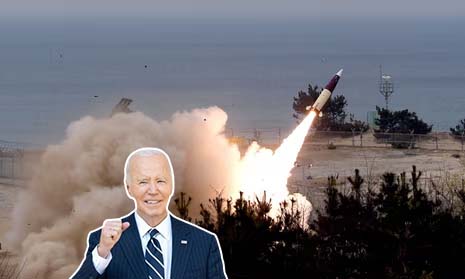
- President Biden authorized Ukraine to use long-range American missiles for strikes against Russia, a move seen by many as an escalation that risks triggering World War 3.
- Russian President Vladimir Putin revised Russia’s nuclear doctrine, lowering the threshold for using nuclear weapons in response to what he described as ‘critical threats’ to its sovereignty and territorial integrity.
- Ukraine, for the first time, used US-made ATACMS missiles to strike deep inside Russian territory, targeting a weapons arsenal in Bryansk.
- Observers speculate that President Biden’s move to arm Ukraine with long-range missiles may complicate the transition period for President-elect Donald Trump, who has vowed to limit military support to Ukraine.
The world is at a very delicate, yet at a critical juncture as the ongoing European war between Russia and Ukraine could soon plunge into World War 3, ever since outgoing US President Joe Biden allowed Ukraine to use its long-range American missile to strike inside Russia. Soon after, without wasting any opportunity, Ukrainian President Volodymyr Zelensky directed its military to use the American missiles to target Russia, prompting Moscow, which said that this means ‘NATO’s direct involvement’ in the war, to update its nuclear doctrine.
Many fear that these quick and precarious developments, that come when Russia-Ukraine has completed 1000 days of being at war, could mean the start of World War – 3. Many are also accusing the outgoing President of escalating the war just months before President-elect Donald Trump is about to take power.
President Biden Allows Ukraine to Use Long-Range Missiles
The face of Russia-Ukraine changed unexpectedly after President Biden authorized Ukraine to use long-range American missiles for strikes against Russia. The decision to allow Kyiv to use these missiles, also known as the Army Tactical Missile Systems, or ATACMS, came in response to Russia’s surprising decision of bringing North Korean troops into the fight.
According to officials aware of the development, the weapons are anticipated to be used primarily against Russian and North Korean forces in an effort to bolster Ukrainian defenses in the western Russian region of Kursk. Nonetheless, the move by the outgoing President has left many worrying about an escalation of the war, which comes just before President-elect Donald Trump, who has vowed to limit military support to Ukraine, takes office.
Ukraine Fires American Long-Range Missile Into Russia
Soon after the allowance, Ukraine, for the first time since and on the 1000th day of war, used long-range American weapons to strike targets deep inside Russia, making full use of its newly-granted powers. According to two US officials, Kyiv hit a Russian weapons arsenal with US-made ATACMS missiles, just two days after President Biden’s authorization. This was then confirmed by the Russian Defense Ministry which noted that Ukraine had “fired six ballistic missiles at a facility in Bryansk”, adding that ATACMS missiles had been used for the same.
Meanwhile, the Ukrainian President neither denied nor confirmed the usage, however said, “Ukraine has long-range capabilities. Ukraine has long-range drones of its own production. We now have a long ‘Neptune’ (Ukrainian cruise missiles) and not just one. And now we have ATACMS. And we will use all of this.”
Russia Lowers Threshold For Nuclear Weapon Usage
On the same day of the attack, Russian President Vladimir Putin revised its nuclear doctrine, lowering the threshold to use nuclear weapons whenever it deems necessary. The move, long-planned, shows Russia’s intent of equating the aggressiveness of Ukraine’s usage of ATACMS missiles because President Putin had clearly indicated that this was his red line which now has been breached. Confirming the news, President Putin’s spokesperson, Dmitry S. Peskov asserted that Russia “reserves the right” to deploy such weapons in response to a conventional-weapons attack posing a “critical threat” to its “sovereignty and territorial integrity.”
The doctrine published and signed by President Putin brings two changes to its nuclear policy, illustrating that Russia is not only trying to threaten Ukraine, but also its ally, the US. Firstly, it introduces the prospect of nuclear weapons being deployed against a nuclear-armed country that indirectly participates in an attack on Russia by backing a non-nuclear state, such as Ukraine and its nuclear-armed supporters led by the United States. Previously, Russia’s nuclear doctrine emphasized responding to direct threats from nuclear-armed entities or alliances. Secondly, it decreases the bar for Russia’s potential nuclear response to conventional attacks. While the 2020 doctrine limited this to scenarios threatening “the very existence of the state,” the revised version broadens it to include any “critical threat” to Russia’s sovereignty.
Nonetheless, the White House downplayed Russia’s new doctrine, with the National Security Council stating that it had observed “no changes to Russia’s nuclear posture.”
President Biden Making It Difficult From Trump’s Transition?
While many say that the Biden administration’s move is inviting World war 3, many also suggest that this is the outgoing President’s way to make the transition period for President-elect Donald Trump a difficult one. It can also be seen as a reversal of Donald Trump’s 2021 Capitol Hill assault, when on January 6 Trump supporters had entered Capitol Hill, the government’s centre in Washington DC, to protest against the results of the 2020 election where Joe Biden had won.
While the Capitol Hill riots marked an “unprecedented assault” in US history, President Biden’s authorization for Ukraine to use American long-range missiles could shift the entire course of history dramatically, with immeasurable ripple effects and an impact on the world.
(Views expressed are the author’s own)
Palak Dogra, a journalist and Delhi University graduate is committed to shedding light on critical international and national developments, aiming to engage the public on issues that truly matter.
